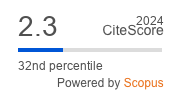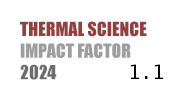ABSTRACT
High-power devices such as fast-charging equipment for new energy vehicles and laser technologies may experience efficiency degradation or even damage due to overheating during operation, making high heat flux cooling technologies a research focus. To address the limited heat-carrying capacity of traditional cooling media, the cooling performance of TiO2 nanofluids under high heat flux conditions was investigated, and a heat transfer experimental test platform under high heat flux density of spray cooling was established. The effects of TiO₂ mass fraction, spray flow rate, and heating power on cooling performance are examined. The results demonstrate that the 0.1 wt% TiO2 nanofluid achieves the optimal performance, with a heat transfer coefficient of 3.59 W/cm²•K. Higher mass fractions lead to increased viscosity and particle interactions, reducing heat transfer efficiency. Furthermore, increasing the spray flow rate enhances cooling performance, but higher TiO₂ concentrations lead to reduced performance due to particle deposition on the heat source surface. The TiO2 nanofluids exhibit significant advantages under high heat flux density. Surface temperature of 25.3°C, at a heating power of 500 W, can be maintained with 0.1 wt% TiO2 nanofluid. This research provides valuable insights for optimizing the use of TiO2 nanofluids in high heat flux density applications.
KEYWORDS
PAPER SUBMITTED: 2025-01-13
PAPER REVISED: 2025-02-14
PAPER ACCEPTED: 2025-02-21
PUBLISHED ONLINE: 2025-04-05
- Chakraborty S., et al., A review on coolant selection for thermal management of electronics and implementation of multiple-criteria decision-making approach, Applied Thermal Engineering, (2024), 245:122807
- Alami AH., et al., Management of potential challenges of PV technology proliferation. Sustainable Energy Technologies and Assessments, (2022), 51:101942
- Hasan HA., et al., Experimental evaluation of thermal efficiency, electrical efficiency, and power production of low-concentrating photovoltaic-thermal system with micro-jet channel, Applied Thermal Engineering, (2024), 236:121526
- Wang Y., et al., A review: The development of crucial solar systems and corresponding cooling technologies, Renewable and Sustainable Energy Reviews, (2023), 185:113590
- Li Y-Y., et al., Theoretical study of heat transfer enhancement mechanism of high alcohol surfactant in spray cooling, International Journal of Thermal Sciences, (2021), 163:106816
- Liu J., et al., Influence of chamber pressure on heat transfer characteristics of a closed loop R134-a spray cooling, Experimental Thermal and Fluid Science, (2016), 75, pp. 89-95
- Chakraborty S., et al., A review on coolant selection for thermal management of electronics and implementation of multiple-criteria decision-making approach, Applied Thermal Engineering, (2024), 245:122807
- Tian J., et al., Experimental investigation on heat transfer performance during electrospray cooling with ethanol-R141b mixture, Applied Thermal Engineering, (2023), 230:120879
- Wang L, R., et al., A holistic and state-of-the-art review of nanotechnology in solar cells, Sustain Energy Technol Assess, (2022), 54:102864
- Sriharan G., et al., A review on thermophysical properties, preparation, and heat transfer enhancement of conventional and hybrid nanofluids utilized in micro and mini channel heat sink, Sustainable Energy Technologies and Assessments, (2023), 58:103327
- Malý M., et al., Effect of nanoparticles concentration on the characteristics of nanofluid sprays for cooling applications, J Therm Anal Calorim, (2019), 135, pp. 3375-3386
- Hsieh S-S., et al., Spray cooling characteristics of nanofluids for electronic power devices, Nanoscale Res Lett, (2015), 10:139
- Souza RR., et al., Recent advances on the thermal properties and applications of nanofluids: From nanomedicine to renewable energies, Applied Thermal Engineering, (2022), 201:117725
- Ravikumar SV., et al., Enhancement of heat transfer rate in air-atomized spray cooling of a hot steel plate by using an aqueous solution of non-ionic surfactant and ethanol, Applied Thermal Engineering, (2014), 64, pp. 64-75
- Huang Y., et al., Experimental study on a spray and falling-film cooling system, Case Studies in Thermal Engineering, (2021), 26:101057
- Peng H., et al., Thermal management of high concentrator photovoltaic system using a novel double-layer tree-shaped fractal microchannel heat sink, Renewable Energy, (2023), 204, pp. 77-93
- Chen L., et al., Performance evaluation of high concentration photovoltaic cells cooled by microchannels heat sink with serpentine reentrant microchannels, Applied Energy, (2022), 309:118478
- Deng Y., et al., Two-stage multichannel liquid-metal cooling system for thermal management of high-heat-flux-density chip array, Energy Conversion and Management, (2022), 259:115591
- Salehi A., et al., A numerical investigation of hydrogen impingement-effusion array jet for a heat sink cooling using solid/porous fins: A thermo-hydrodynamic analysis, International Journal of Hydrogen Energy, (2024), 52, pp. 381-396
- Ong KS., et al., Heat spreading and heat transfer coefficient with fin heat sink, Applied Thermal Engineering, (2017), 112, pp. 1638-1647
- Krishna Murthy K, Reddy KVK, Shaik AS, Badruddin IA, Kamangar S, Bashir MN, et al. Influence of rectangular micro inserts and micro chambers heat transfer characteristics of microchannel heat exchanger, Case Studies in Thermal Engineering, (2025), 65:105362
- Zhang Y., et al., Numerical research on the flow and heat transfer characteristics in the immersion jet cooling for servers, Case Studies in Thermal Engineering, (2024), 60:104748

